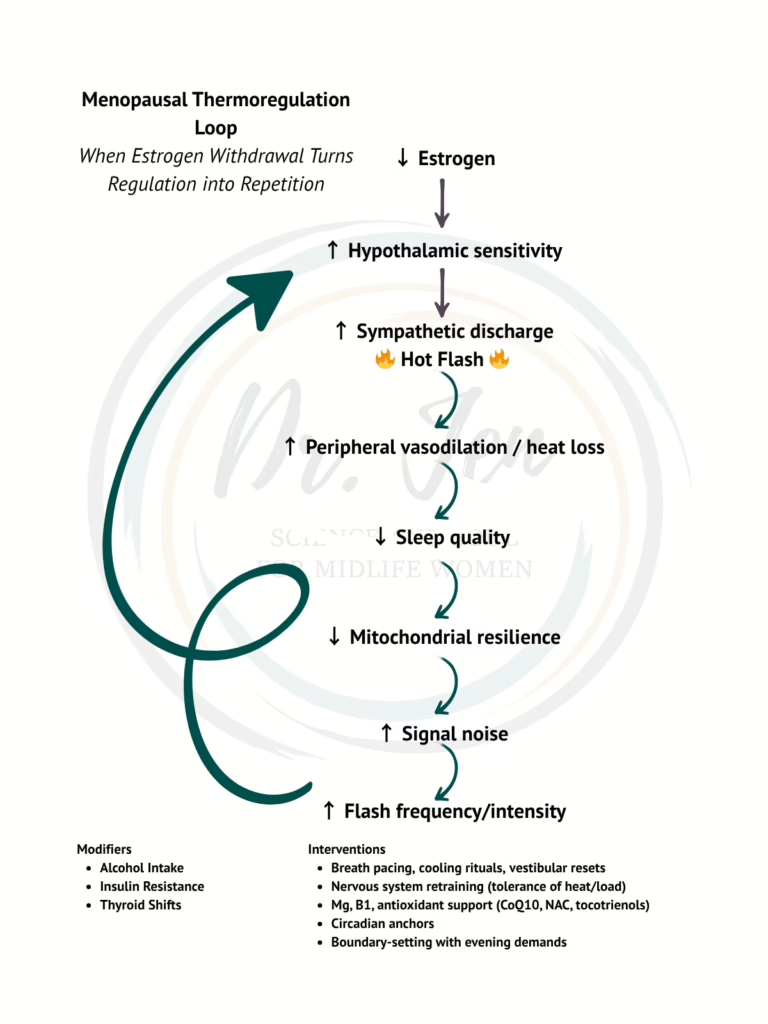🌕 Where nervous system wisdom rewrites the menopause playbook—part of The Reckoning Years series.
Menopause hot flashes get blamed on one thing: estrogen loss.
And while that’s technically true, it’s also wildly incomplete.
Because if it were just about estrogen, then every woman with low estrogen would have hot flashes—and they don’t.
So if your body is surging, sweating, and flaring like clockwork, here’s the truth:
You don’t have a hormone problem. You have a signal problem.
Picture it: you’re in the grocery store aisle, peeling off your sweater, flushed and clammy while strangers stare. Later, you lie awake drenched, wondering why your “normal” labs don’t match the chaos in your body. That mismatch isn’t betrayal—it’s miscommunication.
Menopause Hot Flashes As a Threshold Event.
Not a defect.
Not a glitch.
A full-body signal that your internal thermostat—the one managed by your hypothalamus, mitochondria, and vagus nerve—is losing its margin.
It’s not just about how much estrogen you have.
It’s about how well your body can interpret it.
And that interpretation depends on a few things:
- 🧠 Nervous system tone (braced = hypersensitive)
- 🦠 Inflammatory load (cytokines blunt receptor clarity)
- 🩸 Blood sugar stability (glucose swings = sympathetic surges)
- ⚡ Mitochondrial function (low capacity = overreaction to tiny shifts)
Think of a fever versus a hot flash. Fever is an immune-driven recalibration—the hypothalamus raises the set point on purpose. A menopause hot flash is different. It’s not raising the set point, it’s losing grip on the margin. A tiny blip in temperature is misread as threat, and your system overcorrects with a flush. Fever is design; hot flash is misfire. Both are signals—but the second points to lost resilience.
So when estrogen drops (which it will), your terrain either buffers that shift—or it spirals.

Terrain Roots of Hot Flashes
Here’s what I look at in women with intense hot flashes:
Insulin resistance. Every time blood sugar spikes, cortisol surges in response. Cortisol drives vasodilation, the widening of blood vessels that sets off a hot flash. Women with stable glucose rarely report the same intensity of surges, even with the same estrogen levels.
Cytokine noise. Chronic inflammation—from gut permeability, latent infections, or immune reactivity—creates static in the hormone signaling channels. Estrogen may be present, but the receptors are too gummed up to read it clearly. The result: thermoregulation wobbles.
Low mineral reserve. Magnesium and potassium aren’t sexy, but they’re crucial for nerve conduction and temperature perception. Without them, the thermostat circuitry loses finesse—making overreaction more likely.
Mitochondrial overwhelm. Hot flashes are energetic discharges. If your mitochondria are exhausted, even small demands trigger massive output. Think of it like a frayed electrical grid: one extra appliance flips the whole breaker.
Vagal tone. If your parasympathetic system is flatlined—low HRV, shallow breathing, constant bracing—your thermostat loses flexibility. Instead of adapting, you flare.
And yes, there’s estrogen. But that’s not the starting point. It’s the echo.

Through the Vital Clarity Code Lens
🌱 Regulate
The thermostat can’t stabilize if the terrain is chaos. That’s why rhythm comes first. Morning light, evening dark, meals on time. Protein + fat at breakfast, coffee only after food. These aren’t lifestyle hacks—they’re signals your nervous system can trust. Add breath pacing and micro-unbracing before bed, and the static begins to clear. Regulation is soil. Without it, nothing holds.
🌀 Rewire
Once regulation steadies the ground, you can begin to retrain the system’s interpretation. Six breaths per minute isn’t fluff—it’s nervous system rehab. Circadian cues repeated daily re-etch time into your cells. Gentle movement plus mitochondrial cofactors—magnesium, carnitine, CoQ10—restore the capacity to absorb stress instead of firing off a flare. Rewiring is how you teach your nervous system to read change as shift, not threat.
🔥 Reclaim
This is the refusal to collapse into the story that hot flashes mean you’re broken or doomed to decline. Sensitivity isn’t weakness—it’s data. Reclaiming means listening to what your flashes are mapping: blood sugar chaos, low minerals, shallow breathing, braced tone. Once you stop fighting the symptom and start tracing the signal, you take back authority over your nights and days.
✨ Resonate
On the other side of the flare lies rhythm. At first, hot flashes soften at the edges, then recovery shortens, then whole days pass without a surge. Resonance isn’t perfection—it’s coherence. It’s your thermostat responding in time with your life, not overreacting to every whisper of change.
Micropractice: The Cool Cloth Reset
When a surge hits, don’t fight it. Give your nervous system a new signal.
- Keep a small bowl with a washcloth in the fridge or freezer.
- At the first wave, place the cloth gently over your face, neck, or chest.
- Inhale through your nose, slow exhale through your mouth. Three rounds.
The cool pressure activates trigeminal pathways, calming sympathetic flare. The exhale lowers your heart rate. Instead of escalating, your system gets a reset cue: this is change, not danger.
It won’t erase every flash—but it teaches your body that intensity can pass without panic. Over time, that becomes part of your rewire.
TL;DR
Menopause hot flashes aren’t just about estrogen.
They’re threshold events — signals your terrain has lost margin.
They map blood sugar chaos, inflammatory noise, mitochondrial fatigue, and nervous system rigidity.
Ignore the map and the surges keep screaming.
Read it, and you find where to rebuild.
👉 Ready to decode your own signal? Start with a Vital Signal Check →
Explore the Hot Flashes Hub →
where we decode heat, night sweats, temperature swings, and why the body vents under load.
